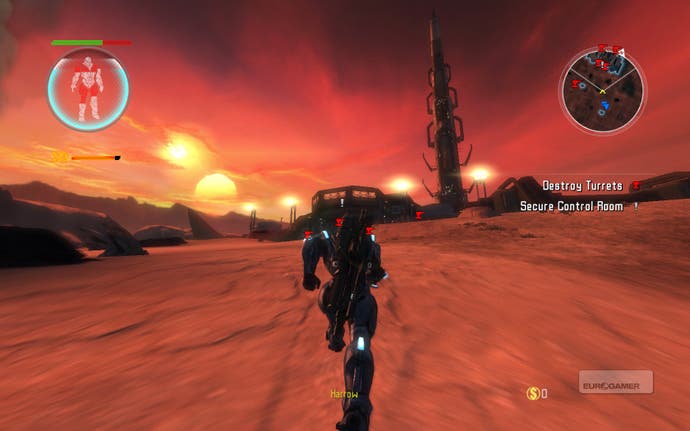Section 8
A hard landing.
And it's not just active equipment and weapons you'll be choosing from: there's a whole bunch of passive modules, with a range of effects, that can also be fiddled with to alter the effectiveness and application of your loadout. I'm sure there will be a bunch of acceptable "optimal" builds as the game goes on, but the variety and possibility space is nevertheless intriguing.
For example, Section 8's armour has two grades of defence. The first is the shield: this is a classic "regeneration over time" system, but it doesn't behave quite how you might expect. Rather than simply being a hit-point buffer it's actually only good for long-range or explosive defence. If you have your shields up and a rocket lands nearby you won't take much damage, but if you're inside a building and someone sets about you close-range with a pistol it'll go straight through to your armour.
People will have their loadouts adjusted with that in mind: a sniper will be keen on high, rapidly recharging shields, while someone defending a capture point inside a building will definitely want high-powered close range weapons, like a shotgun, and hardened armour. Initially the effect of this can be a little baffling: why did that guy beat me? Doesn't my gun work? For folks used to the easy A to B connection of weapons to hit points in other FPS games it doesn't make a lot of sense.
However, it's that "capture point" bit that explains why Section 8's eccentricities make sense in a large picture. There are, I think, two ways a multiplayer can go. Either it makes sense on a very basic, personal level - you shoot that dude enough, with enough skill, and he dies, you win - which props up the very best deathmatch games. Or it makes sense as a team game with team objectives.
Of course there's plenty of overlap to this - I play Quake III capture the flag all the time, and that works both as a team game and as a game of individual skill. However, if you really want to stress team play, and to create a complex set of possibilities for interaction and co-operation between players (more complex than simply capturing the flag, anyway) then it makes sense to focus on team-play systems.

This is what Section 8 has done. Consequently it's never going to be a great "drop in and play" game, and comes off far better when you're playing with a semblance or organisation. Play with a group of players who want to co-operate and it rapidly falls into place. Elements such as the purchase system, allowing you to buy deployables and vehicles, or the aforementioned loadouts, make a lot more sense, and the game becomes an interesting challenge.
To illustrate this I'll run through a game I played the other night. It was a small match, of maybe five aside, on one of the smaller maps. Section 8's Unreal-powered environments are generally beautiful, but a couple are spectacular. This particular map was an island at the base of a space elevator, which you could see disappearing up into the stratosphere.
Anyway, we captured one of the three main base capture points on the map and augmented it with a selection of deployable turrets. Common sense might say that we would lose, two to one, if we only held that single point, but there's even more going on in Section 8 than you might expect, including a bunch of stuff that can only work if you play as a team.








